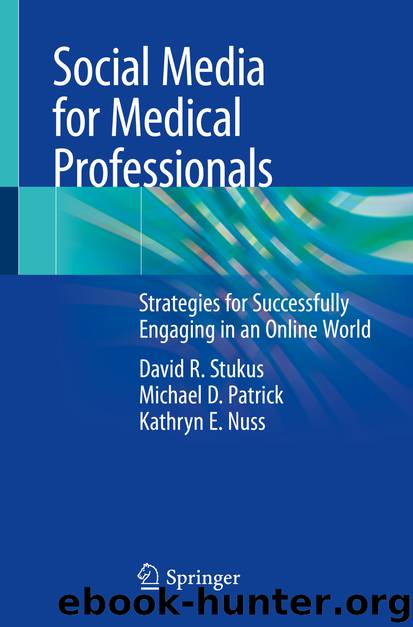Social Media for Medical Professionals by David R. Stukus & Michael D. Patrick & Kathryn E. Nuss

Author:David R. Stukus & Michael D. Patrick & Kathryn E. Nuss
Language: eng
Format: epub
ISBN: 9783030144395
Publisher: Springer International Publishing
2.Fish can be expensive compared to other options, so parents may need ideas for buying fish on a budget.
3.Parents might be concerned about toxins, such as mercury, in fish. They may like reassurance and guidance on eating fish safely.
With these ideas in mind, I could easily create a short blog post with an introduction, three major sections, a conclusion, and a few links to curated content that helps parents overcome the barriers of taste, cost, and toxins. But before I do that, let me consider when and where I want to tell my story. The topic is not seasonal, so now is a good time. Where? Instead of immediately writing a blog post, I could begin at home, in my social media channel. I could engage my followers with a link to the original news story, followed by comments summarizing the science. I could encourage parents of toddlers to offer their kids more fish, outline the barriers, and provide links to resources that help parents overcome each one. I could accomplish this as a series of short posts, comments, or tweets over the course of several hours or days.
I could also look for digital communities with large numbers of my target audience. I do a Google search for “encourage kids to eat fish” and one of the first results is an article in Parenting magazine called “6 Ways to Encourage Your Child to Eat Fish.” [4] Okay, I wonder if Parenting magazine is on Twitter. Yes, it is! In fact, they have over two million followers [5], many of whom are parents of toddlers who would be interested in my message! I write a tweet that states the associations between eating fish, sleeping, and IQ. I include a link to the news story and call out Parenting magazine by including their handle (@parenting) in my tweet. I also call out @ModernMom (412,000 followers) [6] and @PlaygroundDad (347,000 followers) [7] because the Parenting magazine Twitter page told me these are accounts I might also like. Finally, I add a hashtag (#EatMoreFish) that promises to gain more attention.
Out goes my tweet. It gets some likes and retweets, and I gain a few more followers. If @Parenting, @ModernMom or @PlaygroundDad decide to like or retweet my message, I’ll get more traction. As it turns out, they do not engage me, but a couple Twitter users comment on my post. One mentions how difficult it is to get her toddler to eat fish. I share a link from Martha Stewart: “Kid-Friendly Fish and Shell-Fish Recipes” [8] and another from MyFussyeater.com: “10 Kid-Approved Fish Recipes.” [9] More users like and retweet my reply. Others comment with their own kid-friendly fish recipes. Before I know it, there is an entire conversation taking place below my tweet! I respond to all the commenters with another tweet stating fish is expensive. This gets several likes. Another user shares a link to a blog post called “Buying Healthy Fish on a Budget.” [10] I had not seen that one, but I look it up and the post has some great advice.
Download
This site does not store any files on its server. We only index and link to content provided by other sites. Please contact the content providers to delete copyright contents if any and email us, we'll remove relevant links or contents immediately.
When Breath Becomes Air by Paul Kalanithi(7264)
Why We Sleep: Unlocking the Power of Sleep and Dreams by Matthew Walker(5642)
Paper Towns by Green John(4169)
The Immortal Life of Henrietta Lacks by Rebecca Skloot(3826)
The Sports Rules Book by Human Kinetics(3588)
Dynamic Alignment Through Imagery by Eric Franklin(3489)
ACSM's Complete Guide to Fitness & Health by ACSM(3469)
Kaplan MCAT Organic Chemistry Review: Created for MCAT 2015 (Kaplan Test Prep) by Kaplan(3423)
Introduction to Kinesiology by Shirl J. Hoffman(3301)
Livewired by David Eagleman(3123)
The River of Consciousness by Oliver Sacks(2992)
Alchemy and Alchemists by C. J. S. Thompson(2912)
The Death of the Heart by Elizabeth Bowen(2901)
Descartes' Error by Antonio Damasio(2732)
Bad Pharma by Ben Goldacre(2730)
Kaplan MCAT Behavioral Sciences Review: Created for MCAT 2015 (Kaplan Test Prep) by Kaplan(2492)
The Gene: An Intimate History by Siddhartha Mukherjee(2491)
The Fate of Rome: Climate, Disease, and the End of an Empire (The Princeton History of the Ancient World) by Kyle Harper(2436)
The Emperor of All Maladies: A Biography of Cancer by Siddhartha Mukherjee(2431)
